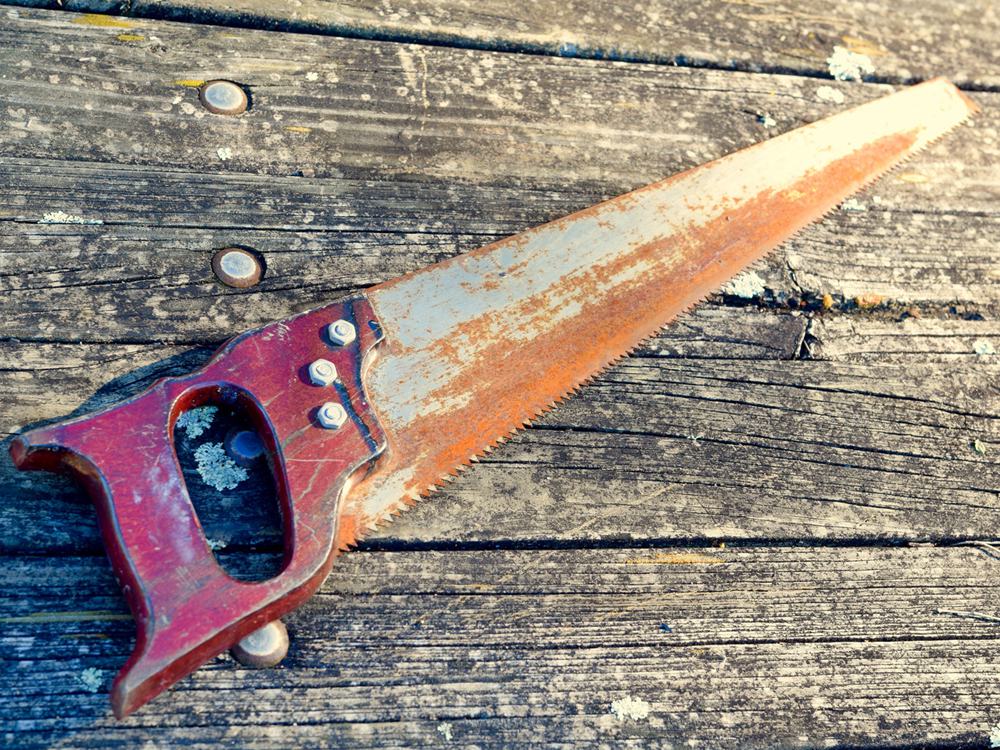
Antique hand saws have long been a fascinating collectible item for woodworkers, enthusiasts, and even casual hobbyists. Their unique design and craftsmanship set them apart from modern saws, providing not only a sense of nostalgia but also an unmatched functional quality. This guide will help you identify these valuable tools and understand their worth in today’s market.
To begin your journey into the world of antique hand saws, you’ll need to familiarize yourself with some key characteristics that distinguish them from their newer counterparts. For example, antique hand saws typically have tight, thick teeth and thin tops, producing narrow slits in contrast to the wider cuts made by modern saws. Additionally, these antiques often feature jointed teeth with straight edges, making them light ground blades.
Once you can confidently identify an antique hand saw, you can start to assess its value. This will depend on factors such as the saw’s age, its maker, and its condition. By honing your knowledge and expertise, you’ll be better equipped to discern the true value of these timeless tools and understand their enduring appeal among collectors and woodworking enthusiasts alike.
Table of Contents
8 Types of Antique Hand Saws and Their Valuation
Rip Saw
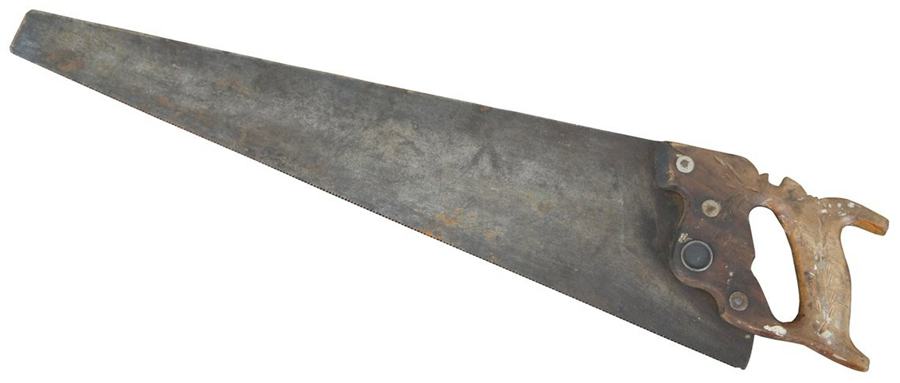
A rip saw is designed for cutting with the grain of the wood. These saws usually have fewer teeth per inch (TPI) and a larger gullet between the teeth for efficient chip removal. When identifying and valuing a rip saw, look for branded saws like Simonds or Atkins. Antique rip saws can have cast iron, zinc, or alloyed steel blades.
Crosscut Saw
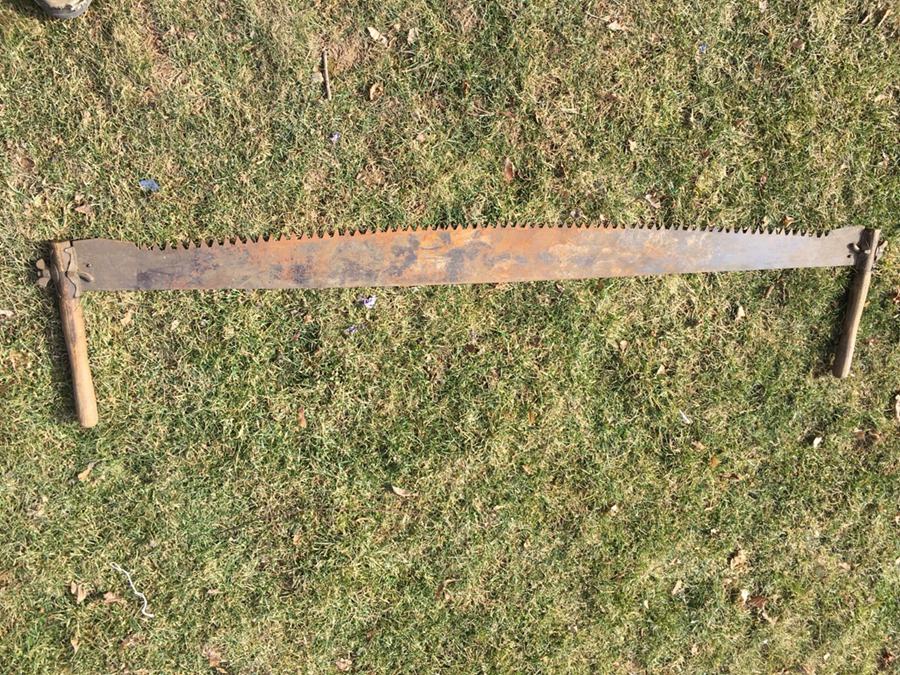
Crosscut saws are used for cutting across the grain of the wood. They have more teeth per inch than rip saws and a different tooth geometry for clean cuts. Single handle and two-man crosscut saws are variations within this category. Antique crosscut saws can be found at auction sites or antique stores and are known for their high-quality blades.
Dovetail Saw
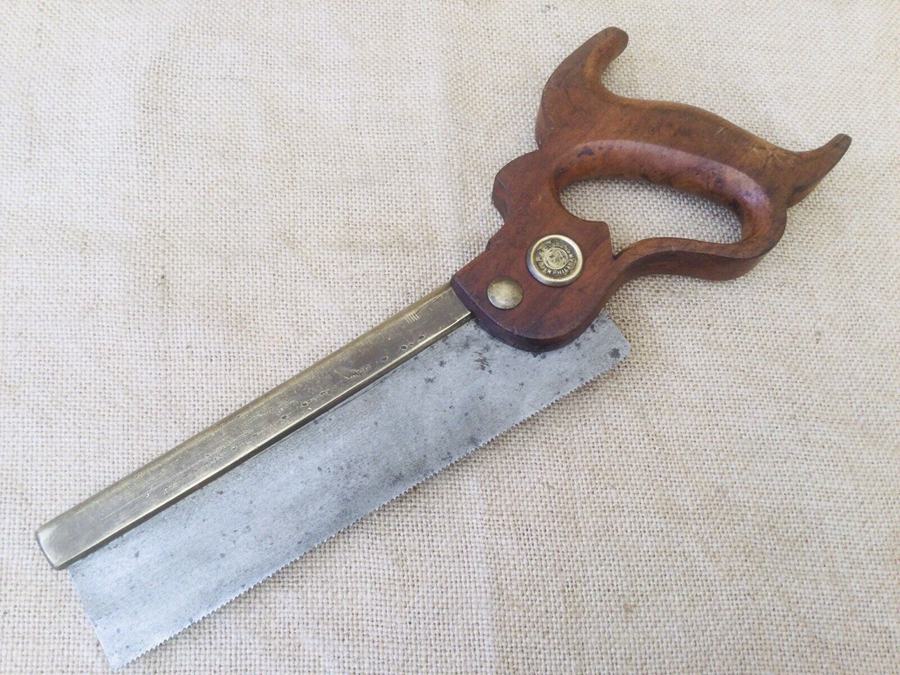
Dovetail saws are a type of backsaw used for precise cuts in woodworking, such as creating dovetail joints. They have fine teeth and a narrow, straight blade. When identifying and valuing an antique dovetail saw, consider factors like the condition of the blade, the brand, and the materials used in its construction.
Back Saw
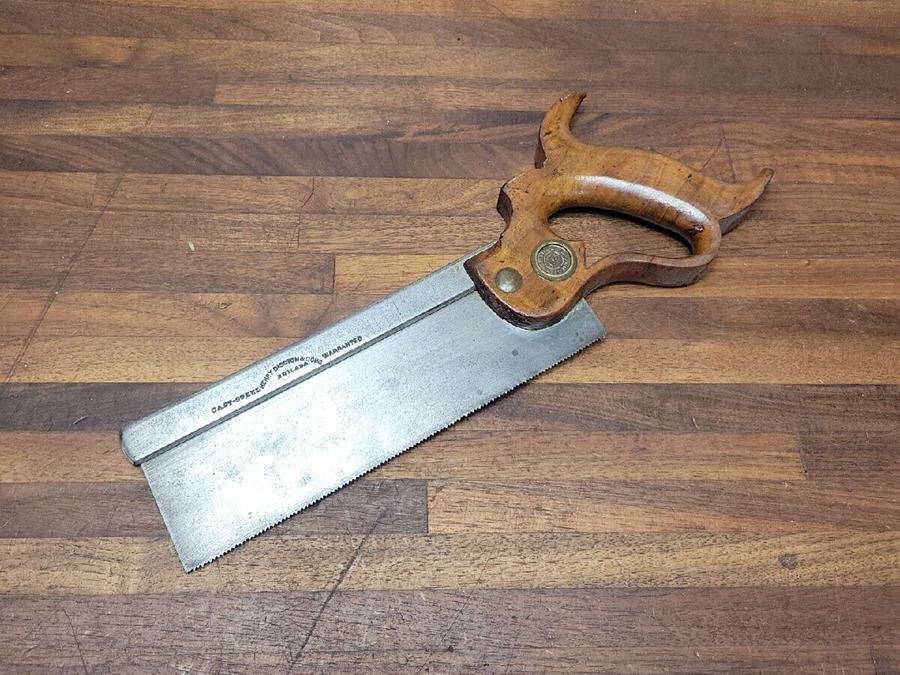
Back saws have a reinforced steel or brass spine to provide rigidity while cutting. This design results in accurate and precise cuts, making them popular for joinery work. Tenon saws and dovetail saws are types of back saws. To value an antique back saw, check for the brand, materials, and the overall condition of both the blade and the spine.
Tenon Saw
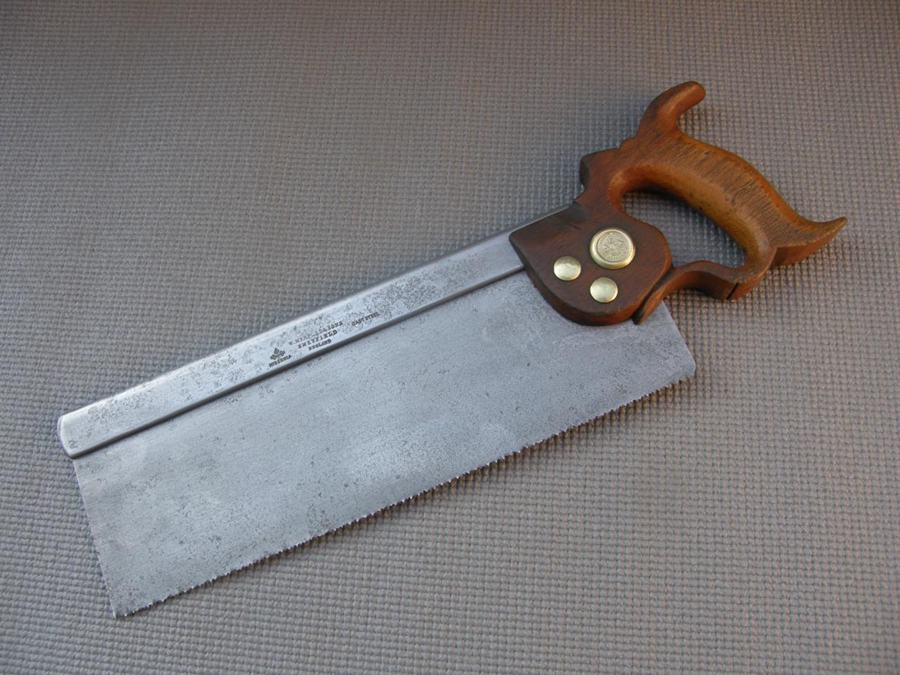
Tenon saws, a type of back saw, are characterized by their relatively short and wide blade. They are used for cutting tenons in woodworking. As with other back saws, valuing an antique tenon saw involves examining the brand, materials, and condition of the blade and spine.
Bow Saw
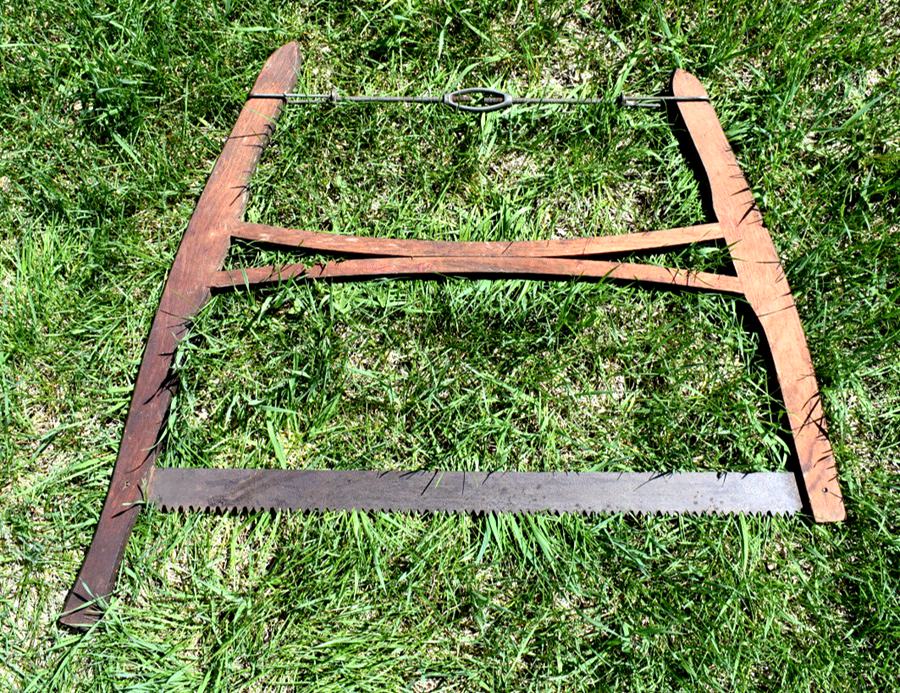
Bow saws have a thin blade held in a frame shaped like a bow. They are used for cutting curves and irregular shapes in wood. Antique bow saws may be identifiable by the materials used in their construction, such as cast iron, brass, or copper, as well as any identifiable maker’s marks.
Keyhole Saw
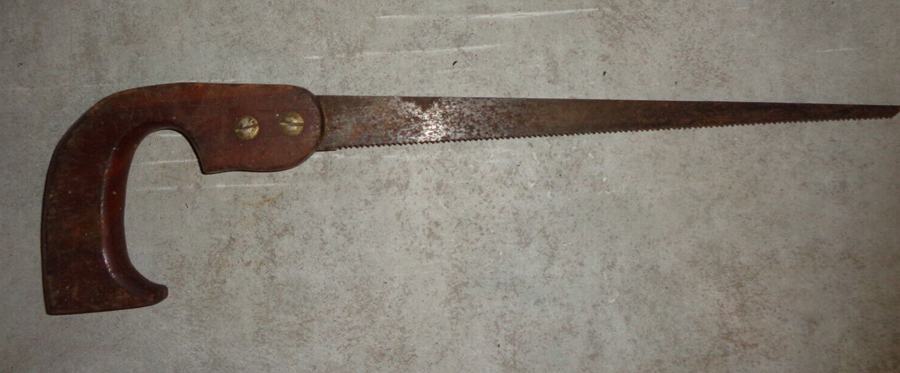
Keyhole saws have a long, narrow blade designed to make intricate cuts, such as cutting keyholes in wood. Antique keyhole saws can be identified and valued by factors such as their material, brand, and condition of the blade.
Coping Saw
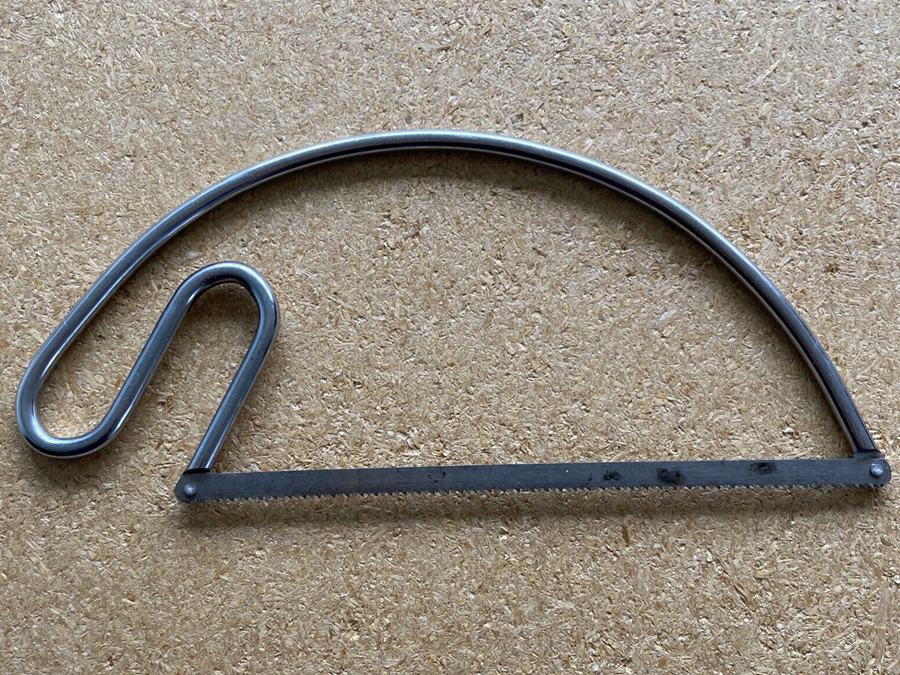
Coping saws are used for cutting intricate shapes in wood, as they have a removable, thin blade held in a deep frame. To identify and value an antique coping saw, look for details like the saw’s brand, materials, and the quality of the blade and frame.
Remember that the value of an antique hand saw depends on factors including its age, condition, brand, and rarity. Always do thorough research and consult experts if necessary to ensure an accurate valuation.
Brands and Manufacturers
When identifying antique hand saws, it’s essential to consider the brand and manufacturer, as different brands have unique characteristics and varying values. Some well-known brands and manufacturers include:
- Simonds Hand Saw
- Disston & Son
- Harvey Peace Company
- E.C Atkins & Co
10 Factors to Identify & Value an Antique Hand Saw
1. Age and History
Antique hand saws date back to the Neolithic era before the stone age, with the earliest accounts of a hand saw in modern civilization dating back to 1500 BC. These tools were found in ancient Egypt and Southern France and have been used for various tasks such as building shelters.
When identifying and valuing an antique hand saw, consider these factors:
- Pre-World War II crosscut saws (1939-1945) usually have wooden handles. Assess the wood for signs of aging, such as scratches, chips, shrinkage, and smell. Old wood often has a unique scent, similar to the aftermath of a rainy day in a wooden cottage.
- Henry Disston & Sons, a renowned antique saw manufacturer, produced saws dating back to 1865. By identifying the maker’s marks and distinctive design features, you can estimate the age of the saw.
Based on these factors, you can approximate value using the table below:
| Antique Hand Saw Age | Average Valuation |
|---|---|
| 1700’s Handmade | $350 – $450 |
| 1800’s Disston & Sons | $200 – $300 |
| Pre-World War II | $150 – $250 |
| Post-World War II | $80 – $150 |
Remember, other elements may also affect the value of an antique hand saw, like overall condition and rarity. However, this table serves as a starting point to help you gauge your antique hand saw’s value.
2. Maker’s Mark or Signature
When identifying antique hand saws, one crucial aspect to consider is the maker’s mark or signature. This typically appears as a stamp or engraving on the metal blade near the handle, indicating the manufacturer or craftsman who created the saw. Identifying the maker’s mark can help you determine the saw’s origin, age, and potentially its value. Here are some points to consider when examining the maker’s mark or signature:
- Familiarize yourself with the most well-known or collectible saw makers, such as Disston, Atkins, and Simonds. Research their specific marks and compare them with the mark on your antique saw.
- Look for any inconsistencies or alterations in the mark. This could indicate a counterfeit or reproduction saw, which would significantly affect its value.
- Consider the condition of the maker’s mark. Is it clear and legible, or has time and use worn it away?
Let’s examine a valuation table, breaking down antique hand saws’ values based on the maker’s mark’s clarity and condition:
| Maker’s Mark Condition | Average Valuation |
|---|---|
| Clear and visible | $400 – $500 |
| Partial, faded | $250 – $350 |
| Illegible or missing | $100 – $200 |
Keep in mind that these valuations are estimates and can vary greatly based on other factors, such as the saw’s age, rarity, and overall condition. Additionally, some makers’ marks may be more valuable than others due to the brand’s prestige or historical significance. Stay vigilant and thoroughly research your saw and its maker’s mark to get the most accurate idea of its value.
3. Material and Quality
When identifying and valuing antique hand saws, it’s essential to pay attention to the material and quality of the saw. Antique hand saws were typically made from high-quality materials, which set them apart from more modern saws.
Blade Material
The first aspect to consider is the blade material. Antique hand saws were often made using:
- High carbon steel: Known for its hardness and durability.
- Cast iron: Frequently used in the early 19th century, these saws are relatively rare.
| Blade Material | Average Valuation |
|---|---|
| High Carbon Steel | $200 – $300 |
| Cast Iron | $350 – $500 |
Handle Material
The handle material can also influence the value of the antique hand saw:
- Wood: Commonly used in antique hand saws, look for hardwoods like beech, cherry, and walnut.
- Brass or Copper: These materials were used in some high-end saws and can increase the value.
| Handle Material | Average Valuation |
|---|---|
| Wood (Hardwoods) | $150 – $250 |
| Brass or Copper | $300 – $400 |
4. Quality and Craftsmanship
The overall quality and craftsmanship of an antique hand saw can significantly impact its value. Look for the following features:
- Tight, thick teeth: Antique saws tend to have a higher number of teeth per inch, making their cuts smoother and more precise.
- Jointed teeth with straight edges: These teeth enhance the cutting ability of the saw.
- Well-made handles with intricate carvings or embellishments: High-end saws may have ornate handles that increase the saw’s value.
Valuation Table for Quality and Craftsmanship
| Quality/Craftsmanship | Average Valuation |
|---|---|
| Simple Design, Basic Quality | $100 – $150 |
| Higher Quality, Plain Handle | $200 – $250 |
| High Quality, Ornate Handle | $350 – $500 |
Remember to take the material and quality into account when identifying and valuing antique hand saws. These factors can significantly impact the saw’s overall worth and appeal to collectors.
5. Style and Design
When identifying and valuing antique hand saws, you should pay attention to the style and design as it can greatly impact their value. In this section, we’ll discuss the aspects of style and design that are important to consider when evaluating antique hand saws.
Blade Design
The blade design of antique hand saws can vary greatly, with some common traits to look out for:
- Tight, thick teeth and thin tops – antique hand saws usually feature thinner blades and tighter, thicker teeth than modern saws.
- Jointed teeth with straight edges – you’ll often find that the teeth on antique saws have a light ground blade and straight edges.
Handle Design & Materials
The handle design and materials used can also play a significant role in antique hand saw valuation. Materials used for handles may include:
- Wood (commonly beech or applewood)
- Brass (found in more ornate or high-quality saws)
- Horn or bone (rare, often found in very high-quality saws)
Additionally, look for any markings, stamps, or manufacturer’s logos on the handle, which can provide important clues about the saw’s origin and age.
Based on the factors discussed, here’s a valuation table for antique hand saw designs:
| Design Features | Average Valuation |
|---|---|
| Basic blade design, wooden handle | $100 – 150 |
| Ornate tooth pattern, wooden handle | $200 – 250 |
| Brass-backed blade, brass handle | $250 – 350 |
| Ornate blade design, bone or horn handle | $400 – 500 |
| Rare tooth pattern, highly decorated, unique handle | $600 – 800 |
Remember that these valuations are just a starting point, and individual antiques may vary based on condition, rarity, and other factors. Take the time to research your specific saw to get a more accurate understanding of its value.
6. Condition
When assessing the value of an antique hand saw, the condition is crucial to consider. Several factors affect the saw’s overall condition, and understanding these factors will help you make an informed decision.
First, examine the blade’s teeth. The saw’s teeth should be sharp and well-maintained, with no missing or damaged teeth. Antique hand saws typically have tight, thick teeth and thin tops, which produce a narrow slit. The teeth should also have straight edges, a feature commonly found in antique saws, making them lighter ground blades.
Next, inspect the handle. A well-preserved handle adds value to the saw. Look for handles made of quality materials such as hardwood, and make sure it is tightly connected to the blade. Check for any cracks or signs of damage that may affect the handle’s stability or appearance.
The saw’s overall appearance plays a significant role in its valuation. Antique hand saws in excellent condition, showing minimal signs of wear or rust, hold the highest value. In contrast, a saw with considerable rust, discoloration, or other cosmetic issues may be worth considerably less.
Here is a valuation table for each of the factors that affect the antique hand saw’s value:
| Condition Factor | Average Valuation |
|---|---|
| Sharp, intact teeth | $150 – 200 |
| Damaged, missing teeth | $50 – 75 |
| Pristine handle | $100 – 150 |
| Cracked, damaged handle | $25 – 50 |
| Excellent overall appearance | $200 – 250 |
| Moderate cosmetic issues | $100 – 150 |
| Significant cosmetic issues | $50 – 75 |
Keep in mind that these valuations are approximate and can vary based on several factors, including the saw’s age and rarity. However, by taking note of the condition aspects listed above and referencing the valuation table, you can gain a better understanding of an antique hand saw’s potential value.
7. Rarity and Uniqueness
When it comes to antique hand saws, rarity and uniqueness play a crucial role in determining their value. As a collector, it’s important to understand the factors that influence the rarity and value of these tools. In this section, you will learn about the characteristics that make antique hand saws unique and how they impact their value.
Antique hand saws can be classified based on various factors, such as age, design, blade quality, and brand. The age of the saw is particularly important, as older models from the 1700s tend to be more valuable due to their historical significance. On the other hand, design and blade quality can also greatly impact the value of antique hand saws. In many cases, unique or rare designs, as well as high-quality blades, can increase the value of a saw significantly.
Here’s a valuation table outlining the factors that affect the value of antique hand saws:
| Factor | Average Valuation |
|---|---|
| Age (1700s models) | $200 – $300 |
| Unique or rare design | $150 – $250 |
| High-quality blade | $100 – $200 |
| Well-known brand | $50 – $150 |
When evaluating the uniqueness of an antique hand saw, consider the following aspects:
- Handle design: Vintage hand saws may have intricately carved handles or unique patterns that set them apart from others.
- Blade etchings: Some antique saws feature ornate etchings on the blade, which can significantly increase their value.
- Tooth configuration: The arrangement of the teeth on a hand saw can vary, making some configurations rarer and more valuable than others.
By keeping these factors in mind, you’ll be better equipped to assess the rarity and uniqueness of antique hand saws and determine their value accurately. Always remember that a more unique and rare antique hand saw will not only be a fascinating addition to your collection but also potentially more valuable in the long run.
8. Provenance or Ownership History
Provenance or ownership history plays a crucial role in determining the value of an antique hand saw. Looking into where the saw came from, who owned it, and how it has been passed down through the years can provide insight into its worth and authenticity.
When assessing the provenance of an antique hand saw, consider the following factors:
- Past owners: Were any of the previous owners well-known or influential in the woodworking field? A connection to a famous craftsman or woodworking shop can significantly increase the saw’s value.
- Usage history: Has the saw been used extensively, or has it been kept in pristine condition? While some collectors might prefer a well-used saw that tells a story, others might value a like-new piece more highly.
- Documentation: Are there any documents, such as receipts, letters, or photographs, that can provide insight into the saw’s history? These can help confirm the saw’s legitimacy and age, as well as offer interesting anecdotes to potential buyers.
To better understand how these factors affect the value of an antique hand saw, take a look at the table below:
| Ownership History Factor | Average Valuation |
|---|---|
| Famous past owner | $600 – $700 |
| Unknown past owner | $300 – $400 |
| Heavy usage history | $250 – $350 |
| Minimal usage history | $500 – $600 |
| Extensive documentation | $550 – $650 |
| Limited documentation | $200 – $300 |
Keep in mind that the values presented in this table are estimates and can vary greatly depending on the specific hand saw. It is essential to take these factors, along with other identifying criteria like age and type, into account when determining the overall value of an antique hand saw. As you dive deeper into your research and learn more about your antique hand saw’s backstory, you’ll become better equipped to appreciate its worth and history.
9. Teeth Per Inch (TPI) and Blade Length
When identifying antique hand saws, it’s essential to consider the number of teeth per inch (TPI) and the blade length. Both factors can shed light on the age, type, and value of the hand saw.
Antique hand saws typically have tight, thick teeth and thin tops, producing a narrow slit in contrast to modern saws. Their jointed teeth with straight edges make them light ground blades. Keep in mind the tooth count when determining the value of an antique hand saw, as the TPI varies among different types of saws.
| TPI Range | Blade Length | Average Valuation |
|---|---|---|
| 2-3 | Up to 8″ | $70 – $100 |
| 7-10 | General-purpose | $100 – $200 |
| 18-32 | Under 1/4″ (thin) | $300 – $350 |
Blade length also plays a role in determining the value of an antique hand saw. Look for saws ranging from 12 – 16 inches in length. The shorter or more compact the saw, the lower the value. However, don’t dismiss branded saws because they can still fetch a higher price.
Using this information on TPI ranges and blade lengths, you can more accurately identify and valuate antique hand saws. Good luck on your antique hand saw hunting journey, and remember to always verify the details!
10. Accessories and Original Parts
When identifying and evaluating the value of antique hand saws, it’s essential to consider the accessories and original parts that come with the saw. These parts can significantly impact the overall value of the antique hand saw and its desirability for collectors.
Handles
The handle of an antique hand saw is one of the key components that can affect its value. Original wooden handles, particularly those made of premium materials like rosewood, can increase the saw’s value. Look for the following attributes in a handle to determine its quality:
- Type of wood: Rosewood, beech, or walnut handles are preferred and generally more valuable.
- Condition: A handle in good condition, without cracks or significant wear, is more valuable.
- Markings: A handle with original manufacturer’s markings or stamps adds to the saw value.
Blades
The blades on antique hand saws come in various forms, such as cross-cut and dado blades. The type and condition of the blade can impact the saw’s value as well. Keep these factors in mind:
- Blade type: Cross-cut or dado blades? Cross-cut blades are generally more collectible and valuable.
- Blade condition: A blade with minimal rust, pitting, or damage will hold a higher value.
- Teeth per inch (TPI): Saws with fewer teeth per inch are typically rarer and more valuable.
Medallions and Screws
Original medallions and screws can add extra value to an antique hand saw. Look for the following factors:
- Manufacturer’s markings: A medallion with the manufacturer’s logo or initials is desirable.
- Material: Brass medallions and screws are more valuable than those made of low-quality materials.
- Condition: Medallions and screws in good condition, without significant damage, add more value.
Here’s a valuation table based on these factors:
| Factor | Average Valuation |
|---|---|
| Handle | |
| Rosewood, good condition | $100 – 150 |
| Beech or walnut, good condition | $50 – 100 |
| Damaged or unmarked | $20 – 50 |
| Blade | |
| Cross-cut, good condition | $60 – 100 |
| Dado, good condition | $40 – 70 |
| Damaged or rusty | $10 – 30 |
| Medallion & Screws | |
| Brass, good condition | $50 – 70 |
| Low-quality metal | $20 – 40 |
| Damaged or missing | $5 – 15 |
Remember to consider these factors when identifying and evaluating an antique hand saw. A combination of high-quality, original parts will significantly increase the saw’s overall desirability and value.
Finding and Collecting Antique Hand Saws
Flea Markets and Auctions
When looking for antique hand saws, flea markets and auctions are excellent places to start your search. Keep an eye out for unique or unusual-looking saws that may have a potential value. Inspect the saws closely for tight, thick teeth and thin tops as these are characteristic of antique hand saws like the antique crosscut saw. Additionally, focus on the handle materials and construction, as older tools typically feature hand-carved or hand-finished surfaces.
Antique Stores and Collectors
Antique stores and specialized tool collectors can be invaluable sources for discovering rare or valuable hand saws. When visiting these locations, take note of the following:
- The manufacturing marks on the tool, as these can offer insight into its age or manufacturer.
- The actual condition of the tool, which will greatly affect its overall value.
- If the tool is made from materials like cast iron, wood, or glass, as these indicate that it is possibly a primitive tool from an earlier era.
In your search, consult with antique tool collectors and dealers. They can provide helpful information about the history and value of specific saws.
Remember that patience and persistence are key when looking for antique hand saws. Take your time to learn about the different types and characteristics of valuable antique tools, such as antique handsaws. Happy hunting!
Final Thoughts
When identifying and determining the value of antique hand saws, you should consider several factors to ensure you acquire an accurate and worthwhile piece. These important elements include the saw’s age, teeth, handle, and overall condition.
To start, remember that older hand saws, particularly those from the 1700s, tend to have a higher value. They will likely be stiffer and thicker than modern saws, usually increasing their worth by 5 – 6%.
Next, examine the teeth of the saw. Antique hand saws typically have tight, thick teeth with thin tops and jointed teeth featuring straight edges. The cuts produced by these saws create a narrow slit, in contrast to modern saws that cut wider. If you find saws with plain, slanted crosscut teeth, you can expect them to have a higher value of around $800 – $900. On the other hand, newer crosscut teeth are more curved, elongated, and primarily machine-shaped, resulting in a lower value of approximately $100 – $150.
The handle design, materials, and overall craftsmanship play a critical role in identifying the saw and determining its value. Look for unique features, intricate designs, and high-quality materials, which often indicate a higher price for antique hand saws.
Lastly, the condition of the saw immensely impacts its value. If you find a rare antique hand saw in good condition, it can sell for a higher price compared to a more common or damaged piece. Generally, the price range for antique Crosscut saws varies from $8 to $425, depending on various factors mentioned above.
In summary, remain vigilant and educated when identifying and valuing antique hand saws. Pay close attention to their age, teeth, handle composition, and overall condition. Equipped with this knowledge, you are now prepared to navigate the world of antique hand saws with confidence.
FAQ
How can I identify the age of an antique hand saw?
To identify the age of an antique hand saw, pay attention to its features, such as teeth size and shape, the thickness of the blade, and the style of the handle. Older saws often have tight and thick teeth with straight edges, making the blades lighter. Additionally, the handle can reveal information about the saw’s age; older models may have handmade handles or distinctive shapes that differ from modern saws.
What factors affect the value of an antique hand saw?
The following factors can affect the value of an antique hand saw:
- Age: The older the saw, the higher its value may be. Saws from the 1700s, for example, can command a higher price than their more recent counterparts.
- Condition: Saws that are in good shape with minimal rust, intact handles, and sharp teeth will be worth more than those with significant wear.
- Rarity: If the saw is a rare or uncommon model or from a well-known maker, its value will likely be higher.
- Demand: The market demand for antique hand saws may fluctuate, but generally, high demand will drive up the value.
How do antique hand saws differ from modern ones?
Antique hand saws typically have a different shape and style compared to modern saws. The teeth on antique saws are usually tight and thick, producing narrow cuts, whereas modern saws have wider teeth that create wider cuts. The handles on antique saws are often unique and handcrafted, while modern handles are mass-produced and more ergonomic.
Can I still use an antique hand saw for woodworking?
Yes, you can use an antique hand saw for woodworking, but keep in mind that restoring and maintaining the saw may be necessary. Antique hand saws often require cleaning, sharpening, and oiling to ensure optimal performance. Additionally, using antique hand saws can add an authentic touch to period woodworking projects, as their narrow cuts and distinctive characteristics can provide a unique finish.








